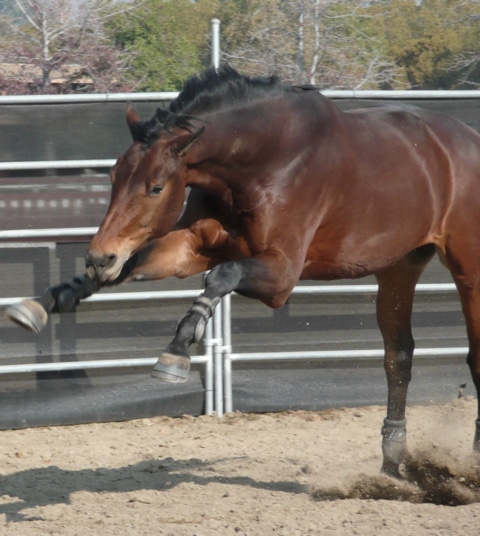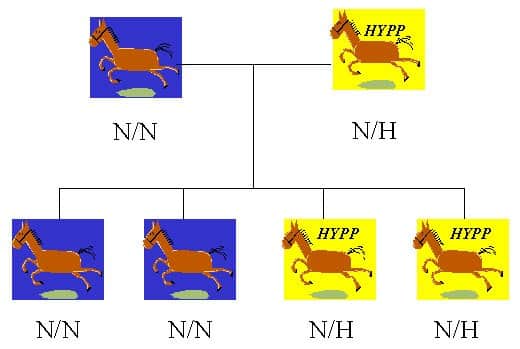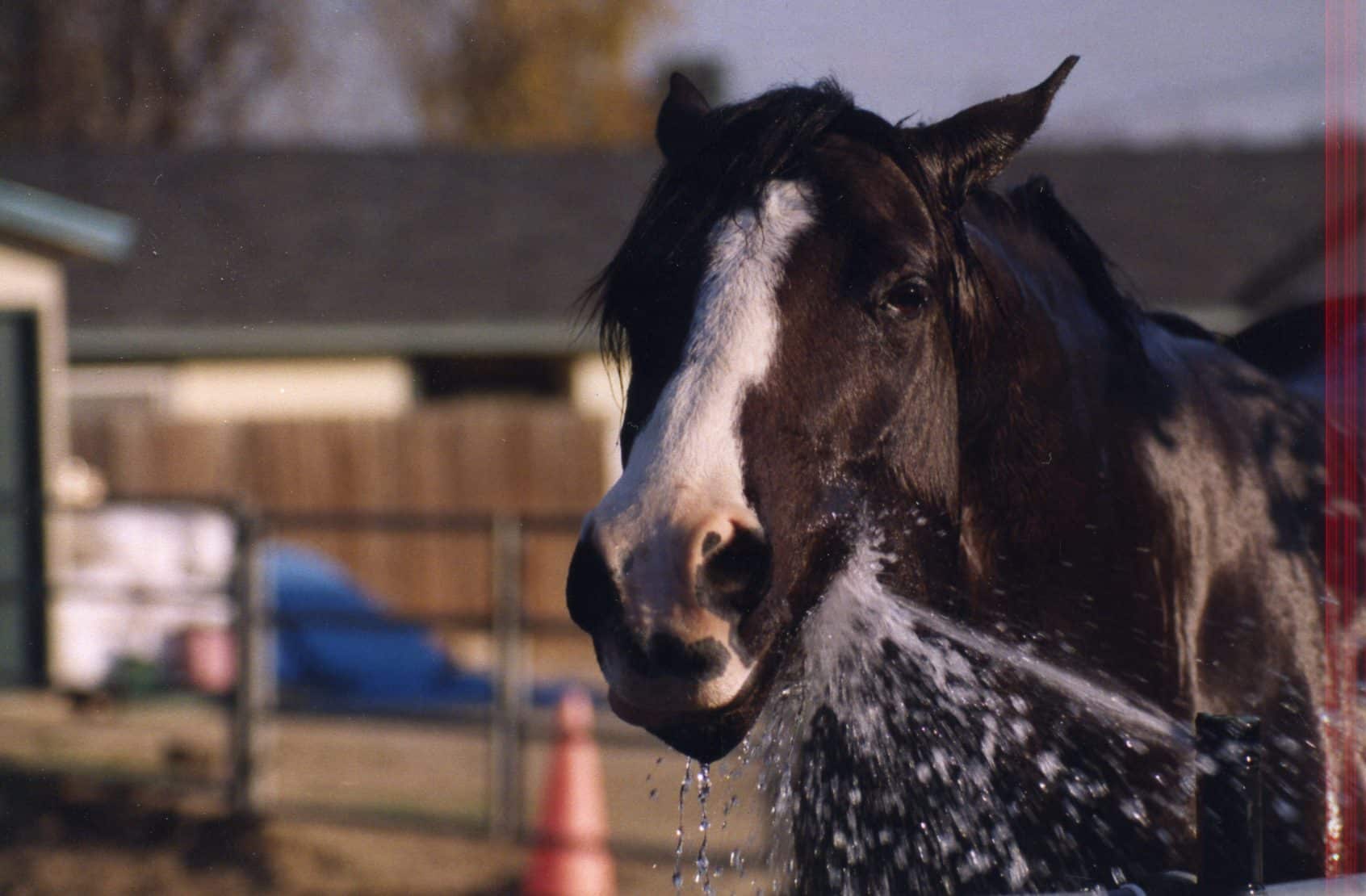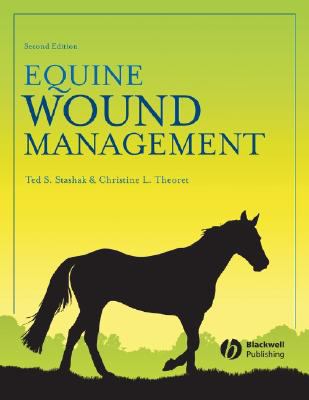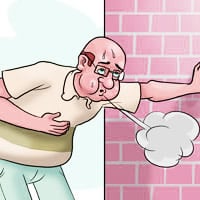 Heaves is a rather awful condition of the horse’s lungs, It actually has a lot of names: heaves (from the “heaving” abdominal breathing that characterizes the condition), chronic obstructive pulmonary disease, COPD, broken wind, bronchiolitis, or recurrent airway obstruction, RAO, and others that I probably don’t know about. Almost undoubtedly, it’s the most common respiratory problem affecting mature, stabled horses. Like many other horse medical problems, heaves is a disease caused by the horse’s environment. It causes a reversible narrowing of the small air passages, with alternating periods of remission and disease.
Heaves is a rather awful condition of the horse’s lungs, It actually has a lot of names: heaves (from the “heaving” abdominal breathing that characterizes the condition), chronic obstructive pulmonary disease, COPD, broken wind, bronchiolitis, or recurrent airway obstruction, RAO, and others that I probably don’t know about. Almost undoubtedly, it’s the most common respiratory problem affecting mature, stabled horses. Like many other horse medical problems, heaves is a disease caused by the horse’s environment. It causes a reversible narrowing of the small air passages, with alternating periods of remission and disease.
Which horses get heaves?
Heaves is mostly commonly seen in stabled horses, and especially dusty stables with poor air circulation (you know who you are). It’s also seen when hay hay isn’t adequately dried. Moist hay can become moldy and dusty; molds and dusts are the sorts of things that trigger the difficult breathing episodes that characterize heaves. Heaves can be seen in horses that are kept in pasture year-round, but mostly it’s a disease of older, mature horses that are kept indoors a lot. There may be breed-related and hereditary aspects – no sex preference has been seen – but those details have not been worked out yet.
What causes heaves?
Horses have apparently been getting heaves since pretty much forever. Aristotle may have even recognized the condition. Heaves was linked to horses eating poor-quality hay fairly early on, as well. In fact, people first thought that bad hay packed up in the intestines, causing pressure on the horse’s diaphragm, with respiratory difficulties as a result (that’s NOT what happens).
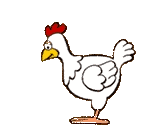 Several things – perhaps several things working together at the same time – affect the horse’s air passages and set off an allergic-type reaction that leads to the characteristic clinical signs. In addition to molds and dust, other factors may trigger heaves; an association between heavey horses and living near chickens has been made. Some people think that viral infections may cause horses to develop heaves; the same sort of thing has been seen in human asthma.
Several things – perhaps several things working together at the same time – affect the horse’s air passages and set off an allergic-type reaction that leads to the characteristic clinical signs. In addition to molds and dust, other factors may trigger heaves; an association between heavey horses and living near chickens has been made. Some people think that viral infections may cause horses to develop heaves; the same sort of thing has been seen in human asthma.
What are the signs of heaves?
Horses with heaves show signs from as mild as an inability to exercise normally and mild cough, to as severe as a full-blown respiratory crisis, where the horses are quite literally gasping for air. Heaves may look like asthma or emphysema in people, but these conditions are actually quite different. Nevertheless, some people may erroneously refer to heavey horses as having “equine asthma.”
Other common signs of heaves include cough and/or a whitish discharge coming from the nostrils. The nostrils may flare open with the effort of each breath. Over time, a “heave line” can develop along the horse’s belly, caused by all of the work that the horse has to do with his abdominal muscles to assist the chest muscles with breathing. In severe cases, horses may even lose weight due to the constant effort and work required to simply breathe.
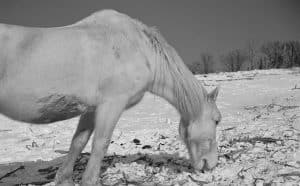 You can hear the breathing, usually best with a stethoscope, but also sometimes from across the barn. The windpipe (trachea) of a heavy horse may be full of secretions, which cause a noisy, turbulent sound. Inside the horse’s chest all sorts of weird and wonderful sounds occur, from wheezes to crackles and high-pitched whistles, to areas where there are very few sounds because the air isn’t flowing well at all.
You can hear the breathing, usually best with a stethoscope, but also sometimes from across the barn. The windpipe (trachea) of a heavy horse may be full of secretions, which cause a noisy, turbulent sound. Inside the horse’s chest all sorts of weird and wonderful sounds occur, from wheezes to crackles and high-pitched whistles, to areas where there are very few sounds because the air isn’t flowing well at all.
Without treatment, horses with heaves may get worse. It’s often seasonal, for example, it may be more prevalent in winter, when horses are kept indoors in poorly ventilated barns. The heavy breathing may worsen when horses are fed poor-quality hay or kept in dusty conditions (and the signs can reverse when the horses are put into well-ventilated situations).
What’s happening in those air passages?
In, the air passages of the lungs narrow (constrict). Narrow air passages make it hard for air to move in and out of the lungs. The smaller the air passages become – the more the constriction – the harder it is for the horse to get air through. Think of trying to move water through a pipe. The bigger the pipe, the easier it is for the water to flow through it, and vice versa. Horses with constricted air passages stand with their chests heaving, trying to get some precious air in and out. When a horse with heaves is exposed to the things that trigger the disease, three things happen.
- The airways become inflamed. Inflammation is actually a local protective response but in the lungs, inflammation leads to a loss of normal lung function.
- The bronchi and brochioles, the lung’s air passages, constrict for reasons that are not fully known (it is known that some of the inflammatory chemicals can cause constriction).
- Mucous is produced. Sticky mucus plugs can sit in the airway and essentially block the passage of air. They can even get so bad as to make it impossible for drugs to get in and help with the disease.
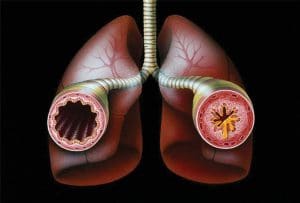 The combination of inflammation, constricted bronchi and mucus buildup in the air passages blocks the flow of air into the lungs. If a horse can’t ventilate his body normally a greater respiratory effort is required to get oxygen into the horse’s body. In long-standing cases, heaves can cause permanent changes in the horse’s lungs, such as lung scarring or increase in the size of the cells of the smooth muscle around the air passages. Once these sorts of changes have occurred, it’s essentially impossible to do anything about them; these horses can be very difficult to treat.
The combination of inflammation, constricted bronchi and mucus buildup in the air passages blocks the flow of air into the lungs. If a horse can’t ventilate his body normally a greater respiratory effort is required to get oxygen into the horse’s body. In long-standing cases, heaves can cause permanent changes in the horse’s lungs, such as lung scarring or increase in the size of the cells of the smooth muscle around the air passages. Once these sorts of changes have occurred, it’s essentially impossible to do anything about them; these horses can be very difficult to treat.
How is heaves diagnosed?
 You diagnose heaves mostly based on its clinical signs. It’s usually pretty hard to overlook a horse that’s gasping for air. Typical histories include things like an older horse confined in a poorly ventilated indoor stable, being given bad hay, and a clinical exam that finds wheezing and crackling lungs. Horses with heaves typically don’t have the fevers that usually accompany infections. Blood tests on heavey horses are usually unremarkable, but they can still be useful because a normal blood test helps to rule out deep-seated infections. In some cases it may be necessary to get into more detailed diagnostic efforts to determine if more subtly affected horses have heaves.
You diagnose heaves mostly based on its clinical signs. It’s usually pretty hard to overlook a horse that’s gasping for air. Typical histories include things like an older horse confined in a poorly ventilated indoor stable, being given bad hay, and a clinical exam that finds wheezing and crackling lungs. Horses with heaves typically don’t have the fevers that usually accompany infections. Blood tests on heavey horses are usually unremarkable, but they can still be useful because a normal blood test helps to rule out deep-seated infections. In some cases it may be necessary to get into more detailed diagnostic efforts to determine if more subtly affected horses have heaves.
How is heaves treated?
If you can treat the cause of heaves, you can eliminate the problem (just like any other health problem, come to think of it). Sadly, eliminating the problem can be very difficult, or at least, very inconvenient. So, for example, if you live in Wisconsin, and your horse has heaves, chances are he’d get a lot better if you moved to Arizona. You can see the problem with that solution, I’m sure, especially if you like cheese.
 The bedrock of successful heaves treatment is environmental management, in particular, dust control and good ventilation. In fact, good studies have shown that the single most effective treatment for heaves is to keep the horse’s environment as dust free and well aired as possible. Several sources of dust may need to be addressed.
The bedrock of successful heaves treatment is environmental management, in particular, dust control and good ventilation. In fact, good studies have shown that the single most effective treatment for heaves is to keep the horse’s environment as dust free and well aired as possible. Several sources of dust may need to be addressed.
Make sure that the horse’s hay is of good quality. The horse spends a good bit of its day eating and breathing in hay dust and all sorts of molds and fungi, as well as dust, can be present in poor-quality hay. The simplest solution to this problem for many horses is to allow them to get their nutrients from pasture, but, of course, this isn’t always possible, particularly if it’s winter. You may need other solutions.
One good way to keep hay dust down to soak it in water for several minutes. Merely hosing the hay flake or sprinkling some water on top of it is unlikely to be of much use. Unfortunately, soaking the hay is labor intensive (and people may get tired of doing it) and it may decrease the nutritional content of the hay if it’s done for long enough. Then there’s the green water to dispose of – hay soaking is not the answer for everyone. But there are plenty of non-dusty complete pelleted feeds, out there, among other alternatives.
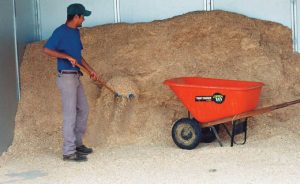 Bedding is a great source of environmental dust. You might think about wetting the stall, but wet bedding is hard to clean and it gets moldy, and causes skin problems, too (it’s always something). Wood shavings are probably better than straw because straw tends to be moldier than shavings anyway. There are lots of bedding alternatives, but they all have their drawbacks, such as difficulty in disposing of them, as well as the charming tendency of the horse to eat them and colic.
Bedding is a great source of environmental dust. You might think about wetting the stall, but wet bedding is hard to clean and it gets moldy, and causes skin problems, too (it’s always something). Wood shavings are probably better than straw because straw tends to be moldier than shavings anyway. There are lots of bedding alternatives, but they all have their drawbacks, such as difficulty in disposing of them, as well as the charming tendency of the horse to eat them and colic.
Good ventilation is extremely important in barns, and it can really help. Still, no matter how good the ventilation system is, it still can’t remove the dust and molds that the horse comes into contact with as a result of the feed and bedding. You have to do everything you can.
Unfortunately, good management may not be easy to do, and especially if you don’t have control over your horse’s environment. Thus, many horses still need medical treatment to try to help with their airway problems.
Medications for heaves
Corticosteroids
The most commonly used, and the most effective, medications used in the treatment of heaves are corticosteroid drugs. They are the only medications that directly counteract the inflammation that occurs in the horse’s lower air passages. While corticosteroids are notorious in some species (including people) for a variety of side effects, happily, in horses, many of those effects, such as weight gain, appear to be largely absent. That said, there is a common concern about the use of corticosteroids – particularly the more potent and long-lasting ones – and the development of laminitis (while such an association has been recognized, no one has ever been able to demonstrate it experimentally). Under any circumstances, it’s probably a good idea to use the lowest dose possible, and as infrequently as can be done to control the disease – as is pretty much the case with all medications.
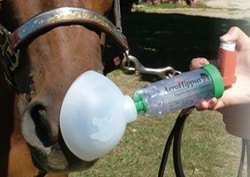 Perhaps the safest and most effective way of administering corticosteroids to horses with heaves is via aerosol preparations. Inhalers provide several advantages for corticosteroid administration: the medication is administered directly into the air passages, the doses used in treatment are quite small, and when given by the aerosol route, much less of the drug is absorbed by the horse, thus greatly decreasing any risk of side effects. Unfortunately, some horses don’t like inhalant medications (with horses, it’s always something), and they tend to be pricey. The cost of medication may ultimately be the determining factor for which method of treatment to choose.
Perhaps the safest and most effective way of administering corticosteroids to horses with heaves is via aerosol preparations. Inhalers provide several advantages for corticosteroid administration: the medication is administered directly into the air passages, the doses used in treatment are quite small, and when given by the aerosol route, much less of the drug is absorbed by the horse, thus greatly decreasing any risk of side effects. Unfortunately, some horses don’t like inhalant medications (with horses, it’s always something), and they tend to be pricey. The cost of medication may ultimately be the determining factor for which method of treatment to choose.
Bronchodilators
Bronchodilators try to get the horse’s constricted air passages to open. Relieving the spasm of the bronchi is a laudable goal, as it should improve the passage of air into the horse’s lungs, but it’s probably not a good idea to use bronchodilators as the sole form of therapy because they don’t get to the root of the problem. Bronchoconstriction is largely a result of inflammation, and treating bronchoconstriction without treating inflammation is pretty futile. Using bronchodilators without making changes in the horse’s environment probably isn’t a great idea either – you sure don’t want to open up the horse’s airways and thus increase the amount of material getting down into them.
Other medications
 There are lots of other medication options. Unfortunately, none of them appear to be particularly good options. While it would make sense to try to loosen up the mucus in the air passages of horses with heaves, however, there’s not really any good evidence to suggest that there’s a practical way to do this. Antihistamines get used a lot, although there is essentially no evidence that they are effective. Immunostimulants, and non-steroidal anti-inflammatory drugs such as phenylbutazone appear to have little use. Antibiotics are only indicated when a concurrent infection exists. Finally, cough suppressants should probably not be used in horses with heaves, because even if they did work, coughing is a necessary means by which the horse clears the mucous secretions from its lungs.
There are lots of other medication options. Unfortunately, none of them appear to be particularly good options. While it would make sense to try to loosen up the mucus in the air passages of horses with heaves, however, there’s not really any good evidence to suggest that there’s a practical way to do this. Antihistamines get used a lot, although there is essentially no evidence that they are effective. Immunostimulants, and non-steroidal anti-inflammatory drugs such as phenylbutazone appear to have little use. Antibiotics are only indicated when a concurrent infection exists. Finally, cough suppressants should probably not be used in horses with heaves, because even if they did work, coughing is a necessary means by which the horse clears the mucous secretions from its lungs.
“Alternative” approaches
Whenever treatment is frustrating, temporary, or ineffective (as is often the case with heaves) there are bound to be lots of “alternatives” proposed. These alternatives – acupuncture, homeopathy, herbal medicines, supplements and the like – all have one thing in common. None of them have been shown to be effective. You probably won’t hurt your horse if you trying something “alternative:” just your wallet or pocketbook. The most effective and most “natural” treatment for heaves is environmental management, but it’s not sexy.
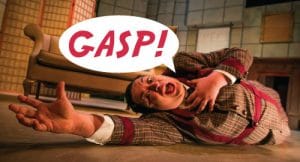 What is the likely outcome of horses with heaves?
What is the likely outcome of horses with heaves?
Believe it or not, there are very few reports of the long-term outcome of the management of heavey horses. Good environmental management plays a critical role in successful outcome, however, studies have shown that people routinely fail to employ or maintain the recommendations for changing the conditions that cause the problem in the first place (probably because of the time, expense, and dedication required). That’s really too bad because most horses with heaves can be helped, at least to some extent. It just takes a lot of effort.



